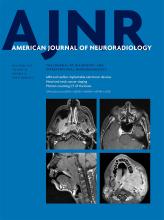Index by author
Adeeb, N.
- EDITOR'S CHOICENeurointerventionYou have accessPredictors of Incomplete Occlusion following Pipeline Embolization of Intracranial Aneurysms: Is It Less Effective in Older Patients?N. Adeeb, J.M. Moore, M. Wirtz, C.J. Griessenauer, P.M. Foreman, H. Shallwani, R. Gupta, A.A. Dmytriw, R. Motiei-Langroudi, A. Alturki, M.R. Harrigan, A.H. Siddiqui, E.I. Levy, A.J. Thomas and C.S. OgilvyAmerican Journal of Neuroradiology December 2017, 38 (12) 2295-2300; DOI: https://doi.org/10.3174/ajnr.A5375
This was a retrospective analysis of 465 consecutive aneurysms treated with the Pipeline Embolization Device between 2009 and 2016, at 3 academic institutions in the United States. Cases with angiographic follow-up were selected to evaluate factors predictive of incomplete aneurysm occlusion at last follow-up. Older age (more than 70 years), nonsmoking status, aneurysm location within the posterior communicating artery or posterior circulation, greater aneurysm maximal diameter (>21 mm), and shorter follow-up time (<12 months) were significantly associated with incomplete aneurysm occlusion at last angiographic follow-up.
Al-dasuqi, K.
- Extracranial VascularOpen AccessAssociation between Carotid Plaque Features on CTA and Cerebrovascular Ischemia: A Systematic Review and Meta-AnalysisH. Baradaran, K. Al-Dasuqi, A. Knight-Greenfield, A. Giambrone, D. Delgado, E.J. Ebani, H. Kamel and A. GuptaAmerican Journal of Neuroradiology December 2017, 38 (12) 2321-2326; DOI: https://doi.org/10.3174/ajnr.A5436
Altmeyer, W.B.
- Pediatric NeuroimagingOpen AccessBasion–Cartilaginous Dens Interval: An Imaging Parameter for Craniovertebral Junction Assessment in ChildrenA.K. Singh, Z. Fulton, R. Tiwari, X. Zhang, L. Lu, W.B. Altmeyer and B. TantiwongkosiAmerican Journal of Neuroradiology December 2017, 38 (12) 2380-2384; DOI: https://doi.org/10.3174/ajnr.A5400
Alturki, A.
- EDITOR'S CHOICENeurointerventionYou have accessPredictors of Incomplete Occlusion following Pipeline Embolization of Intracranial Aneurysms: Is It Less Effective in Older Patients?N. Adeeb, J.M. Moore, M. Wirtz, C.J. Griessenauer, P.M. Foreman, H. Shallwani, R. Gupta, A.A. Dmytriw, R. Motiei-Langroudi, A. Alturki, M.R. Harrigan, A.H. Siddiqui, E.I. Levy, A.J. Thomas and C.S. OgilvyAmerican Journal of Neuroradiology December 2017, 38 (12) 2295-2300; DOI: https://doi.org/10.3174/ajnr.A5375
This was a retrospective analysis of 465 consecutive aneurysms treated with the Pipeline Embolization Device between 2009 and 2016, at 3 academic institutions in the United States. Cases with angiographic follow-up were selected to evaluate factors predictive of incomplete aneurysm occlusion at last follow-up. Older age (more than 70 years), nonsmoking status, aneurysm location within the posterior communicating artery or posterior circulation, greater aneurysm maximal diameter (>21 mm), and shorter follow-up time (<12 months) were significantly associated with incomplete aneurysm occlusion at last angiographic follow-up.
Amans, M.R.
- NeurointerventionYou have accessPial Artery Supply as an Anatomic Risk Factor for Ischemic Stroke in the Treatment of Intracranial Dural Arteriovenous FistulasS.W. Hetts, A. Yen, D.L. Cooke, J. Nelson, P. Jolivalt, J. Banaga, M.R. Amans, C.F. Dowd, R.T. Higashida, M.T. Lawton, H. Kim and V.V. HalbachAmerican Journal of Neuroradiology December 2017, 38 (12) 2315-2320; DOI: https://doi.org/10.3174/ajnr.A5396
Andres, A.
- Pediatric NeuroimagingOpen AccessGestational Age at Birth and Brain White Matter Development in Term-Born Infants and ChildrenX. Ou, C.M. Glasier, R.H. Ramakrishnaiah, A. Kanfi, A.C. Rowell, R.T. Pivik, A. Andres, M.A. Cleves and T.M. BadgerAmerican Journal of Neuroradiology December 2017, 38 (12) 2373-2379; DOI: https://doi.org/10.3174/ajnr.A5408
Andreu-arasa, V.C.
- FELLOWS' JOURNAL CLUBHead and Neck ImagingYou have accessCT Texture Analysis Potentially Predicts Local Failure in Head and Neck Squamous Cell Carcinoma Treated with ChemoradiotherapyH. Kuno, M.M. Qureshi, M.N. Chapman, B. Li, V.C. Andreu-Arasa, K. Onoue, M.T. Truong and O. SakaiAmerican Journal of Neuroradiology December 2017, 38 (12) 2334-2340; DOI: https://doi.org/10.3174/ajnr.A5407
This was a retrospective study including 62 patients diagnosed with primary head and neck squamous cellcarcinoma who underwent contrast-enhanced CT examinations for staging, followed by chemoradiotherapy. CT texture features of thewhole primary tumor were measured using an in-house developed Matlab-based texture analysis program. Histogram, gray-level co-occurrence matrix, gray-level run-length, gray-level gradient matrix, and Laws features were used for texture feature extraction. Three histogram features (geometric mean, harmonic, and fourth moment) and 4 gray-level run-length features (short-run emphasis, gray-level nonuniformity, run-length nonuniformity, and short-run low gray-level emphasis) were significant predictors of outcome.
Arrigoni, F.
- Pediatric NeuroimagingOpen AccessAnterior Mesencephalic Cap Dysplasia: Novel Brain Stem Malformative Features Associated with Joubert SyndromeF. Arrigoni, R. Romaniello, D. Peruzzo, A. De Luca, C. Parazzini, E.M. Valente, R. Borgatti and F. TriulziAmerican Journal of Neuroradiology December 2017, 38 (12) 2385-2390; DOI: https://doi.org/10.3174/ajnr.A5360
Badger, T.M.
- Pediatric NeuroimagingOpen AccessGestational Age at Birth and Brain White Matter Development in Term-Born Infants and ChildrenX. Ou, C.M. Glasier, R.H. Ramakrishnaiah, A. Kanfi, A.C. Rowell, R.T. Pivik, A. Andres, M.A. Cleves and T.M. BadgerAmerican Journal of Neuroradiology December 2017, 38 (12) 2373-2379; DOI: https://doi.org/10.3174/ajnr.A5408
Baek, J.H.
- Head and Neck ImagingYou have accessEfficacy and Safety of Ethanol Ablation for Branchial Cleft CystsE.J. Ha, S.M. Baek, J.H. Baek, S.Y. Shin, M. Han and C.-H. KimAmerican Journal of Neuroradiology December 2017, 38 (12) 2351-2356; DOI: https://doi.org/10.3174/ajnr.A5373








